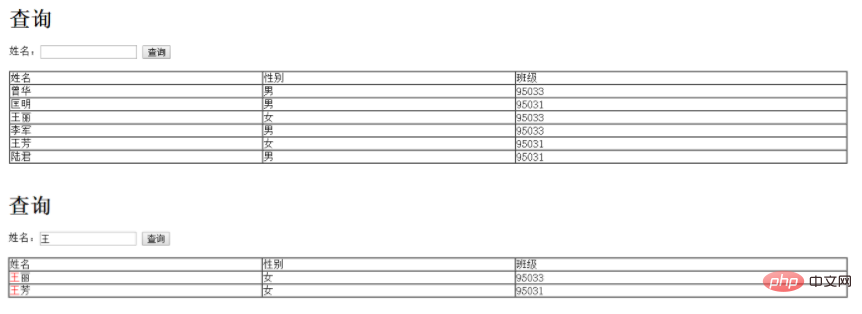How to implement conditional query in php
How to implement conditional query in php: first call the previously encapsulated class; then use keyword fuzzy query; then create a form, submit the data to the current page, extract the keyword query; and finally use PHP code Traverse the elements in the table and turn the keywords into red.

Recommended: "PHP Video Tutorial"
1. Single condition Query is a query with only one condition:
1. First call the previously encapsulated class, and then use keywords to fuzzy query:
<?php //单查询
require "DBDA.class.php";//调取封装类
$db=new DBDA;
$Sname="";//创建变量,为了后面可以让Sname在表单中显示
$sql="select * from t_student";
if(!empty($_POST["Sname"]))//确定是否存在数据
{
$Sname=$_POST["Sname"];
$sql="select * from t_student where Sname like '%{$Sname}%' ";//模糊查询
}
?>2. Create a form, submit the data to the current page, and extract the keyword query:
<form action="chaxun.php" method="post"><!--因为查询数据在当前页面,所以提交到当前页面-->
<div>姓名:<input type="text" name="Sname" value="<?php echo $Sname ?>" />
<input type="submit" value="查询" /></div>
</form><br />
<table width="100% " border="1" cellpadding="0" cellspacing="0">
<tr>
<td>姓名</td>
<td>性别</td>
<td>班级</td>
</tr>3. Traverse the elements in the table and turn the keywords into red:
<?php
$arr=$db->query($sql);
foreach($arr as $v)
{
$str = str_replace($Sname,"<span style='color:red'>{$Sname}</span>",$v[1]);//用span标签使关键字变为红色,
echo "<tr>
<td>{$str}</td>
<td>{$v[2]}</td>
<td>{$v[4]}</td>
</tr>";
}
?>Final result:

## 2. Multi-condition query:
1. First make a form and create a table to display the table:
<table width="100%" border="1" cellpadding="0" cellspacing="0">
<tr>
<td>代号</td>
<td>名称</td>
<td>系列</td>
<td>上市时间</td>
<td>价格</td>
</tr>
</table>2. Call the encapsulation class, create corresponding conditions, and check whether the data is empty :
<?php
require "DBDA.class.php";
$db=new DBDA();//1.如果没有提交数据,显示所有//2.如果有提交数据,根据关键字查询显示$name="";
$tj1=" 1=1 "; //第一个条件,对应名称,要用空格隔开$tj2=" 1=1 ";//第二个条件,对应系列,要用空格隔开if(!empty($_POST["name"]))
{
$name = $_POST["name"];
$tj1 = " name like '%{$name}%' ";
}if(!empty($_POST["brand"]))
{
$brand = $_POST["brand"];
$tj2 = " brand = '{$brand}' ";
}//总条件$tj=" {$tj1}and{$tj2} ";
$sql="select * from car where".$tj;?>3. Use PHP code to traverse the database table and turn the keywords into red (php should be embedded in the table):
<?php
$arr = $db->query($sql);foreach($arr as $v)
{
$str = str_replace($name,"<span style='color:red'>{$name}</span>",$v[1]);
echo "<tr>
<td>{$v[0]}</td>
<td>{$str}</td>
<td>{$v[2]}</td>
<td>{$v[3]}</td>
<td>{$v[7]}</td>
</tr>";}?>The final result is:


The above is the detailed content of How to implement conditional query in php. For more information, please follow other related articles on the PHP Chinese website!

Hot AI Tools

Undresser.AI Undress
AI-powered app for creating realistic nude photos

AI Clothes Remover
Online AI tool for removing clothes from photos.

Undress AI Tool
Undress images for free

Clothoff.io
AI clothes remover

Video Face Swap
Swap faces in any video effortlessly with our completely free AI face swap tool!

Hot Article

Hot Tools

Notepad++7.3.1
Easy-to-use and free code editor

SublimeText3 Chinese version
Chinese version, very easy to use

Zend Studio 13.0.1
Powerful PHP integrated development environment

Dreamweaver CS6
Visual web development tools

SublimeText3 Mac version
God-level code editing software (SublimeText3)

Hot Topics
 1664
1664
 14
14
 1423
1423
 52
52
 1318
1318
 25
25
 1269
1269
 29
29
 1248
1248
 24
24
 Explain JSON Web Tokens (JWT) and their use case in PHP APIs.
Apr 05, 2025 am 12:04 AM
Explain JSON Web Tokens (JWT) and their use case in PHP APIs.
Apr 05, 2025 am 12:04 AM
JWT is an open standard based on JSON, used to securely transmit information between parties, mainly for identity authentication and information exchange. 1. JWT consists of three parts: Header, Payload and Signature. 2. The working principle of JWT includes three steps: generating JWT, verifying JWT and parsing Payload. 3. When using JWT for authentication in PHP, JWT can be generated and verified, and user role and permission information can be included in advanced usage. 4. Common errors include signature verification failure, token expiration, and payload oversized. Debugging skills include using debugging tools and logging. 5. Performance optimization and best practices include using appropriate signature algorithms, setting validity periods reasonably,
 PHP Program to Count Vowels in a String
Feb 07, 2025 pm 12:12 PM
PHP Program to Count Vowels in a String
Feb 07, 2025 pm 12:12 PM
A string is a sequence of characters, including letters, numbers, and symbols. This tutorial will learn how to calculate the number of vowels in a given string in PHP using different methods. The vowels in English are a, e, i, o, u, and they can be uppercase or lowercase. What is a vowel? Vowels are alphabetic characters that represent a specific pronunciation. There are five vowels in English, including uppercase and lowercase: a, e, i, o, u Example 1 Input: String = "Tutorialspoint" Output: 6 explain The vowels in the string "Tutorialspoint" are u, o, i, a, o, i. There are 6 yuan in total
 Explain late static binding in PHP (static::).
Apr 03, 2025 am 12:04 AM
Explain late static binding in PHP (static::).
Apr 03, 2025 am 12:04 AM
Static binding (static::) implements late static binding (LSB) in PHP, allowing calling classes to be referenced in static contexts rather than defining classes. 1) The parsing process is performed at runtime, 2) Look up the call class in the inheritance relationship, 3) It may bring performance overhead.
 What are PHP magic methods (__construct, __destruct, __call, __get, __set, etc.) and provide use cases?
Apr 03, 2025 am 12:03 AM
What are PHP magic methods (__construct, __destruct, __call, __get, __set, etc.) and provide use cases?
Apr 03, 2025 am 12:03 AM
What are the magic methods of PHP? PHP's magic methods include: 1.\_\_construct, used to initialize objects; 2.\_\_destruct, used to clean up resources; 3.\_\_call, handle non-existent method calls; 4.\_\_get, implement dynamic attribute access; 5.\_\_set, implement dynamic attribute settings. These methods are automatically called in certain situations, improving code flexibility and efficiency.
 PHP and Python: Comparing Two Popular Programming Languages
Apr 14, 2025 am 12:13 AM
PHP and Python: Comparing Two Popular Programming Languages
Apr 14, 2025 am 12:13 AM
PHP and Python each have their own advantages, and choose according to project requirements. 1.PHP is suitable for web development, especially for rapid development and maintenance of websites. 2. Python is suitable for data science, machine learning and artificial intelligence, with concise syntax and suitable for beginners.
 PHP in Action: Real-World Examples and Applications
Apr 14, 2025 am 12:19 AM
PHP in Action: Real-World Examples and Applications
Apr 14, 2025 am 12:19 AM
PHP is widely used in e-commerce, content management systems and API development. 1) E-commerce: used for shopping cart function and payment processing. 2) Content management system: used for dynamic content generation and user management. 3) API development: used for RESTful API development and API security. Through performance optimization and best practices, the efficiency and maintainability of PHP applications are improved.
 PHP: A Key Language for Web Development
Apr 13, 2025 am 12:08 AM
PHP: A Key Language for Web Development
Apr 13, 2025 am 12:08 AM
PHP is a scripting language widely used on the server side, especially suitable for web development. 1.PHP can embed HTML, process HTTP requests and responses, and supports a variety of databases. 2.PHP is used to generate dynamic web content, process form data, access databases, etc., with strong community support and open source resources. 3. PHP is an interpreted language, and the execution process includes lexical analysis, grammatical analysis, compilation and execution. 4.PHP can be combined with MySQL for advanced applications such as user registration systems. 5. When debugging PHP, you can use functions such as error_reporting() and var_dump(). 6. Optimize PHP code to use caching mechanisms, optimize database queries and use built-in functions. 7
 The Enduring Relevance of PHP: Is It Still Alive?
Apr 14, 2025 am 12:12 AM
The Enduring Relevance of PHP: Is It Still Alive?
Apr 14, 2025 am 12:12 AM
PHP is still dynamic and still occupies an important position in the field of modern programming. 1) PHP's simplicity and powerful community support make it widely used in web development; 2) Its flexibility and stability make it outstanding in handling web forms, database operations and file processing; 3) PHP is constantly evolving and optimizing, suitable for beginners and experienced developers.




